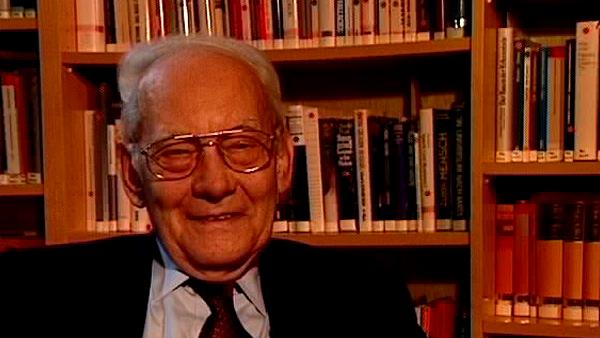NEXT STORY

Using primers to see single particles
RELATED STORIES

NEXT STORY

Using primers to see single particles
RELATED STORIES


|
Views | Duration | |
|---|---|---|---|
| 81. Rudolf Rigler: looking at fluctuations | 182 | 02:32 | |
| 82. Rigler's method of determining the rotation of single molecules | 84 | 02:46 | |
| 83. Reasons to focus into a small volume element | 89 | 01:46 | |
| 84. Using fluorescence correlation spectroscopy to observe a single... | 453 | 03:25 | |
| 85. Using primers to see single particles | 70 | 04:26 | |
| 86. Using nanotechnology to do evolutionary experiments | 57 | 04:20 | |
| 87. Viruses | 63 | 03:39 | |
| 88. Using viruses as models for evolution | 42 | 02:57 | |
| 89. The evolution of HIV | 48 | 03:28 | |
| 90. Anti-viral strategies | 38 | 04:49 |


We make the volume element so small that no fluorescing molecule generally is inside, and you will say so what? If you want to measure a fluorescence signal you want to have as many as possible molecules in there. That's right if you measure the average single strength. But as I've said already, we measure the fluctuation, and the fluctuation is strongest if you've only a single event, because the square root of one is one. So, what does it mean now with our method? We sit there and wait until a molecule diffuses into that volume element. It's not steadily in there, but occasionally it diffuses in. And once it diffuses in it will be excited. The volume element is as large that the diffusing molecule spends about a millisecond or a tenth of a millisecond inside. And since the fluorescence lifetime is of the order of 10-8 to 10-9 seconds, it means when the molecule is inside the volume element it emits many fluorescence light quanta because it gets excited, multiply, and emits many thousands or ten thousand light quanta. So you get a burst of light quanta, and then nothing again. And this burst can be measured, but of course you want to... since a molecule spends most time outside the volume element, the burst occurs only occasionally and if you would measure it steadily you wouldn't see very much, the noise would overthrow it.
So here comes in the, we say it, fluorescence correlation spectroscopy. You do correlation, or auto-correlation, a method invented by Norbert Wiener in the '30s... a mathematician at MIT. Auto-correlation means you simply don't pick up only the intensity as it appears at your measuring device, you take the intensity at a time, T, and multiply it with the intensity you measure in the next time element, T + ΔT. So you don't pick up single intensities, you pick up products of intensities. Now you see, if you have a noise then one of the intensities is high but at the next time moment there is nothing, so the product is zero. Zero times any number is zero. But if there are a thousand or ten thousand light quanta while a molecule is inside the light cavity, the next time element will be also. And you integrate over the whole and suddenly you see wonderful element, and you see already you're observing a single molecule. The method wouldn't work if you would have to average over many molecules. At the moment where you pick up your light quanta, there's one molecule inside your volume light cavity and you can pick up. So this is a very sensitive method.
Nobel Prize winning German biophysical chemist, Manfred Eigen (1927-2019), was best known for his work on fast chemical reactions and his development of ways to accurately measure these reactions down to the nearest billionth of a second. He published over 100 papers with topics ranging from hydrogen bridges of nucleic acids to the storage of information in the central nervous system.
Title: Using fluorescence correlation spectroscopy to observe a single molecule
Listeners: Ruthild Winkler-Oswatitch
Ruthild Winkler-Oswatitsch is the eldest daughter of the Austrian physicist Klaus Osatitsch, an internationally renowned expert in gas dynamics, and his wife Hedwig Oswatitsch-Klabinus. She was born in the German university town of Göttingen where her father worked at the Kaiser Wilhelm Institute of Aerodynamics under Ludwig Prandtl. After World War II she was educated in Stockholm, Sweden, where her father was then a research scientist and lecturer at the Royal Institute of Technology.
In 1961 Ruthild Winkler-Oswatitsch enrolled in Chemistry at the Technical University of Vienna where she received her PhD in 1969 with a dissertation on "Fast complex reactions of alkali ions with biological membrane carriers". The experimental work for her thesis was carried out at the Max Planck Institute for Physical Chemistry in Göttingen under Manfred Eigen.
From 1971 to the present Ruthild Winkler-Oswatitsch has been working as a research scientist at the Max Planck Institute in Göttingen in the Department of Chemical Kinetics which is headed by Manfred Eigen. Her interest was first focused on an application of relaxation techniques to the study of fast biological reactions. Thereafter, she engaged in theoretical studies on molecular evolution and developed game models for representing the underlying chemical proceses. Together with Manfred Eigen she wrote the widely noted book, "Laws of the Game" (Alfred A. Knopf Inc. 1981 and Princeton University Press, 1993). Her more recent studies were concerned with comparative sequence analysis of nucleic acids in order to find out the age of the genetic code and the time course of the early evolution of life. For the last decade she has been successfully establishing industrial applications in the field of evolutionary biotechnology.
Tags: Massachusetts Institute of Technology, MIT, fluorescence correlation spectroscopy, fluorescing molecule, fluctuation, auto-correlation, Delta T, Norbert Wiener
Duration: 3 minutes, 26 seconds
Date story recorded: July 1997
Date story went live: 29 September 2010